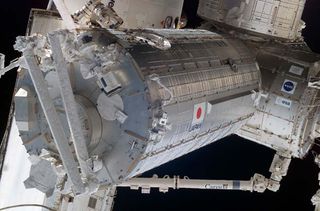Space Station Ready to Flex Japanese Robotic Arm

Thisstory was updated at 12:37 p.m. EDT.
HOUSTON - Astronautsaboard the International Space Station (ISS) successfully flexed and folded afledgling robotic arm Monday to check the external reach of the outpost's new Japanese lab.
Discoveryshuttle astronauts extended the six-jointed arm of Japan?s newly installed billion-dollarKibo laboratory out to its full 33-foot (10-meter) length before tucking itaway for future tests.
?It wassuch a pretty view,? Japanese astronaut Akihiko Hoshide told Japan?s mission controllersat the Tsukuba Space Center today after reaching out with Kibo?s robotic limb.
Hoshide andNASA spaceflyer Karen Nyberg inched the arm throughits first twitches on Saturday, when they moved it slightly to clear spaceso two spacewalkers could remove insulation covers and unlock a window at theend of Japan?s 37-foot (11-meter) Kibo lab. But their test today with stationastronaut Gregory Chamitoff marked the first large deployment of the newrobotic arm.
?It?ll bequite dramatic,? said Annette Hasbrook, lead station flight director forDiscovery?s flight, in a Sunday briefing here at NASA?s Johnson Space Center.?It?ll practically extend all the way out, and then move down and fold in onitself.?
Kibo?s mainrobotic arm weighs about 1,719 pounds (780 kg) and can haul objects as massiveas 15,432 pounds (7,000 kg). It launched with its Kiboparent module aboard the shuttle Discovery on May 31. The shuttle?sseven-astronaut crew, commanded by veteran astronaut Mark Kelly, is due toreturn to Earth Saturday after wrapping up the new lab?s installation aboardthe station.
Get the Space.com Newsletter
Breaking space news, the latest updates on rocket launches, skywatching events and more!
?It?s notgoing to move around, not like the station arm,? said Hoshide, representing theJapan Aerospace Exploration Agency (JAXA) in a NASA interview before flight.?It?s going to sit there.?
The spacestation?s 57-foot (17-meter) Canadarm2 robotic arm can crawl from one spot toanother outside the orbiting lab?s hull like an inchworm.
Kibo?srobotic arm is built solely for manipulating experiments on the laboratory?sporch-like platform slated to be launched aboard a NASA shuttle next year,Hoshide said. A smaller Japanese robotic arm, to be used for finer actions, isalso planned for launch later.
Today?sflex and fold exercises will set the stage for five more shakedown tests in thecoming months by the space station?s three-man Expedition 17 crew. The finaltest is expected to end in the Japanese robotic limb?s first grapple onto anattachment point outside the station.
?We?ll getthe opportunity to see that arm to do its thing several times over the summer,?said space station flight director Emily Nelson early Monday.
In additionto the robotic arm tests, all 10 astronauts aboard the docked station andshuttle are expected to discuss their mission with reporters on Earth laterthis afternoon.
They?realso expected to reopen the Kibo?s storage room, a squat 14-foot (4.4-meter)room that was movedto laboratory?s rooftop berth on Friday. The attic-like storage space hasno defined use, and can serve as an extra closet for space-starved astronautsaboard the station.
?You canimagine how full your house gets as you go through life, but you can never havea garage sale or very infrequently take things away,? Nelson said. ?This willprovide some much needed storage space.?
NASA isbroadcasting Discovery's STS-124 mission live on NASA TVon Saturday. Click here forSPACE.com's shuttle mission updates and NASA TV feed.
- New Video: Moving Day for Station's Kibo Attic
- New Video: Grand Opening for Station's Kibo Lab
- Video: Liftoff! Discovery Launches Into Space
Join our Space Forums to keep talking space on the latest missions, night sky and more! And if you have a news tip, correction or comment, let us know at: community@space.com.

Tariq is the Editor-in-Chief of Space.com and joined the team in 2001, first as an intern and staff writer, and later as an editor. He covers human spaceflight, exploration and space science, as well as skywatching and entertainment. He became Space.com's Managing Editor in 2009 and Editor-in-Chief in 2019. Before joining Space.com, Tariq was a staff reporter for The Los Angeles Times covering education and city beats in La Habra, Fullerton and Huntington Beach. In October 2022, Tariq received the Harry Kolcum Award for excellence in space reporting from the National Space Club Florida Committee. He is also an Eagle Scout (yes, he has the Space Exploration merit badge) and went to Space Camp four times as a kid and a fifth time as an adult. He has journalism degrees from the University of Southern California and New York University. You can find Tariq at Space.com and as the co-host to the This Week In Space podcast with space historian Rod Pyle on the TWiT network. To see his latest project, you can follow Tariq on Twitter @tariqjmalik.
Most Popular

